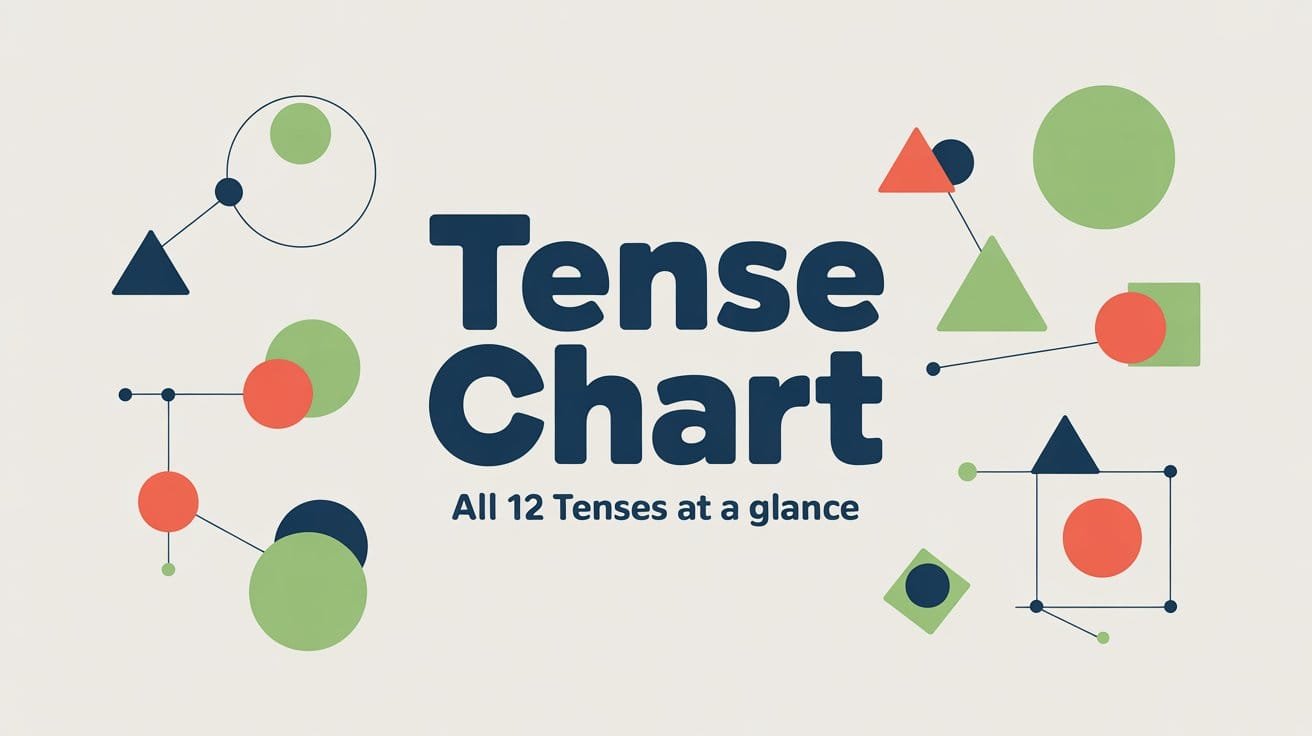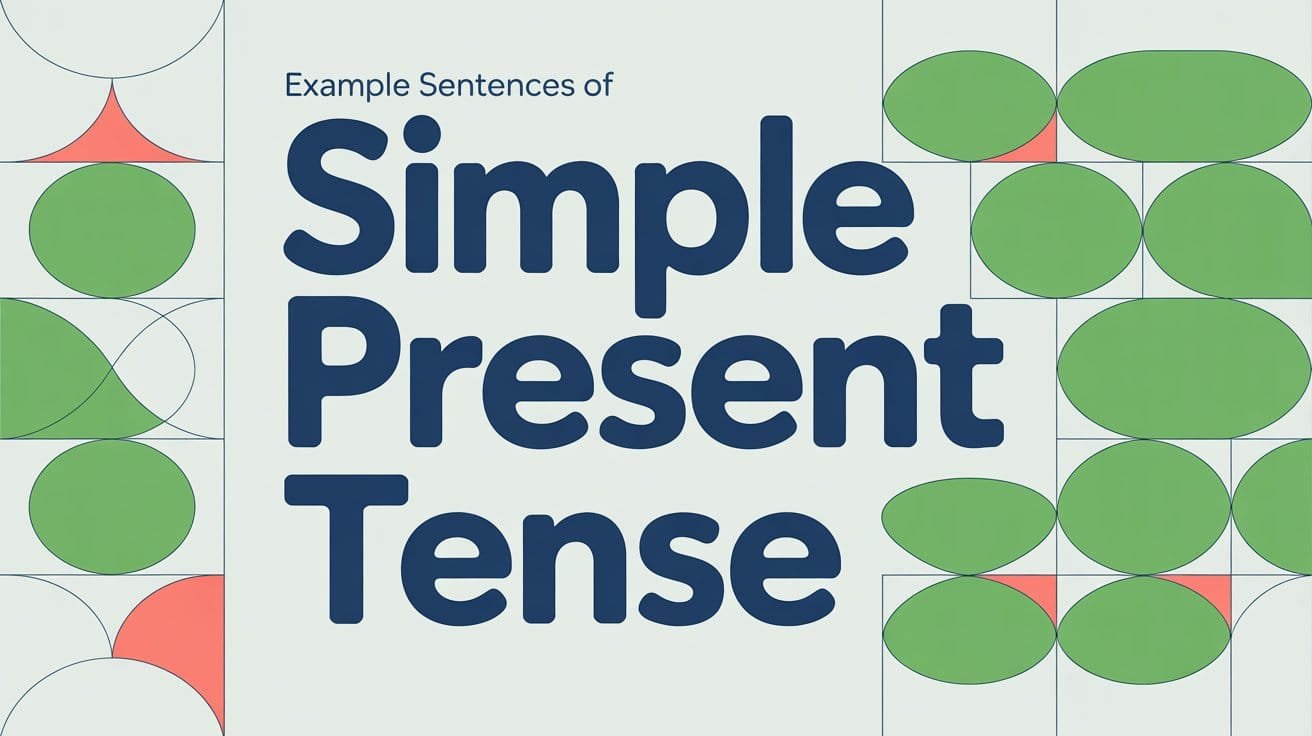English grammar has twelve tenses, each used to show time and action in different ways. For many learners, keeping them all straight can be confusing. That’s why a tense chart is helpful. It organizes each tense with its form, use, and example so you can spot the patterns quickly.
In this guide, you’ll find a complete chart of all 12 tenses in English, along with simple examples and clear explanations. It’s a go-to resource for reviewing verb forms, comparing tenses, or just getting a better grasp of how English handles time.
What Is a Tense Chart in English Grammar?
A tense chart is a visual tool that shows how different verb tenses are formed and used in English. It brings together the structure, time reference, and examples of all twelve tenses in one place, making it easier to compare and understand them.
Instead of learning each tense separately, a chart helps you:
- See how the tenses are grouped (present, past, future)
- Understand how verb forms change
- Identify when to use each tense based on time and context
For English learners, this kind of reference is especially helpful when writing, speaking, or correcting tense-related mistakes. With the right examples and structure, the chart turns a complex topic into something you can quickly review and apply.
English Tense Chart (With Examples and Structure)
The chart below covers all 12 verb tenses in English, grouped by present, past, and future. Each entry includes the tense name, a clear example, a short usage note, and the structure (how the tense is formed).
Present Tenses
| Tense | Example | Usage | Structure |
|---|---|---|---|
| Present Simple | I read every night. | Regular actions or facts | Subject + base verb |
| Present Continuous | She is studying for her exam. | Actions happening now | Subject + am/is/are + verb+ing |
| Present Perfect | They have visited that museum. | Past actions with present relevance | Subject + have/has + past participle |
| Present Perfect Continuous | He has been working since morning. | Ongoing actions that started in the past and continue now | Subject + have/has been + verb+ing |
Past Tenses
| Tense | Example | Usage | Structure |
|---|---|---|---|
| Past Simple | We watched the movie yesterday. | Completed actions in the past | Subject + past verb |
| Past Continuous | I was reading when she called. | Actions in progress at a specific time in the past | Subject + was/were + verb+ing |
| Past Perfect | She had left before the rain started. | Action completed before another past action | Subject + had + past participle |
| Past Perfect Continuous | They had been waiting for an hour. | Ongoing action before another past event | Subject + had been + verb+ing |
Future Tenses
| Tense | Example | Usage | Structure |
|---|---|---|---|
| Future Simple | I will call you tomorrow. | Decisions, promises, or predictions | Subject + will + base verb |
| Future Continuous | She will be working at 6 PM. | Ongoing future actions | Subject + will be + verb+ing |
| Future Perfect | He will have finished by noon. | Action completed before a future point | Subject + will have + past participle |
| Future Perfect Continuous | They will have been traveling for five hours. | Duration of an ongoing future action | Subject + will have been + verb+ing |
Common Mistakes Learners Make with Tense Charts
While tense charts make learning easier, they can also lead to confusion if misunderstood. Here are some common mistakes learners make, and how to avoid them:
Mixing up similar tenses
Many learners confuse tenses like past simple and present perfect. For example, using “I have seen her yesterday” instead of “I saw her yesterday.” The presence of a specific past time (yesterday) calls for past simple, not present perfect.
Overusing the continuous forms
Some learners try to use continuous tenses for everything, such as “I am knowing the answer.” Not all verbs work in continuous forms, especially stative verbs like know, believe, or like.
Ignoring time signals
Words like since, for, already, yesterday, and by the time are useful cues that help match the correct tense. Missing these signals often leads to incorrect choices.
Using tense charts as rules rather than references
A chart gives patterns, not hard rules for every sentence. English has exceptions, and context matters. The chart is a tool, but learning through examples and real usage is equally important.
How to Use This Tense Chart Effectively
A tense chart is more than just a list. It’s a learning tool you can return to again and again. Here are some ways to get the most out of it:
- Compare tenses side by side: Use the chart to spot the differences in structure and usage between similar tenses, like past perfect and past simple. This helps you choose the right form when writing or speaking.
- Review sentence patterns regularly: Instead of memorizing rules in isolation, read and say the examples out loud. Noticing how each tense works in context builds natural understanding over time.
- Refer back when writing or editing: If you’re unsure which tense fits, scan the chart to see which one matches the time and meaning you want to express. This is especially helpful when revising emails, essays, or practice exercises.
- Practice with purpose: Pick a few tenses you struggle with and focus on them during writing or grammar practice. The chart can act as your guide while you build confidence in using each form.
Quick Reference: All 12 Tenses at a Glance
This compact chart gives you a fast overview of each tense, its basic structure, and an example. Use it for quick checks or revision.
| Tense | Structure | Example |
|---|---|---|
| Present Simple | base verb | I walk to school. |
| Present Continuous | am/is/are + verb+ing | She is reading. |
| Present Perfect | have/has + past participle | We have eaten. |
| Present Perfect Continuous | have/has been + verb+ing | He has been studying. |
| Past Simple | past verb | They played soccer. |
| Past Continuous | was/were + verb+ing | I was cooking. |
| Past Perfect | had + past participle | She had left early. |
| Past Perfect Continuous | had been + verb+ing | We had been working. |
| Future Simple | will + base verb | I will call you. |
| Future Continuous | will be + verb+ing | She will be sleeping. |
| Future Perfect | will have + past participle | He will have arrived. |
| Future Perfect Continuous | will have been + verb+ing | They will have been driving. |
Final Thoughts
Learning how to use verb tenses correctly takes time, but a clear chart can make it easier. Instead of memorizing everything at once, treat this tense chart as a reference you can return to as needed, whether you’re writing, speaking, or reviewing grammar.
Focus on understanding the patterns and practicing them in real sentences. Over time, you’ll feel more confident choosing the right tense based on context and purpose.




This is very very useful
helped me a lot during my exams
must learn from this website if you are struggling with english
Thank you so much Fatima for your wonderful feedback! We are thrilled to hear that our website proved to be extremely helpful for you during your exams. Your success and progress are truly our greatest rewards. Happy learning!
Very nise usiful tesne
Thank you! We’re glad you found the tense explanation helpful. Happy learning!
What a easy way to explain or learn grammar for someone trough this website….Big thanks for al of this contribution for us.
Thank you so much for your kind words and appreciation! We’re delighted to hear that you found our website to be an easy and effective way to learn grammar. We wish you all the best on your grammar journey. Happy learning!
I don’t really understand…… can you make it easier by eradicating those formulars used????
Thank you for your comment! We appreciate your feedback and understand that learning English tenses can be challenging.
To delve deeper into each tense, We recommend using the search box on our website. Simply type the name of the tense you’d like to explore (e.g., Simple Present Tense) to access the in-depth details and examples we’ve provided in individual posts.
Feel free to explore at your own pace, and if you have any questions along the way, don’t hesitate to reach out.
Thank you so much 😊 its very help to me. iam really struggling to learn grammar but I don’t full understand.but finallly I get this website it takes to understand only a minute.iam I appreciated you may allah protect you evil eye.
You’re welcome! We’re glad the website helped you understand grammar quickly. Your kind words mean a lot. Wishing you success in your learning journey!
I need positive, negative, interrogative sentence structure of past tenses
Hi Saleha,
Please check out the below articles…
Simple past tense
Past Continuous
Past Perfect Tense
Past Perfect Continuous
Very helpful.Thank you so much.
What a easy way to learn tenses I really struggle to learn tenses! This website help me to learn tenses easily
Very nice 🙂🙂🙂👍👍👍👍👍
thanks for this tenses this is very helpful…
Thanks for this tenses this is very helpful
nice tense.. very understand
It is very useful Nd easy to remember. Its Improve our English vocabulary
thank you
do halefull
Nice💘✌🏻
Thanks for the love!
it very useful for kinds
good
excellent and very easy to learn
excellent and very easy to learn
Thanks ❤️
Wonderful 💯
This website is wonderful. I got 100/98 Mark’s in English Grammer in Class 7
Do you what is the participle form of awake. It is written awaked it will be awoken
Thank you for pointing that out! It appears there was a mistake in the verb list. We have fixed and updated it. We appreciate your diligence in helping us maintain accuracy. If you have any further questions or feedback, feel free to let us know.
Thank you so much , It’s very help full and it’s explain very good. It’s amazing and knowledgeable.